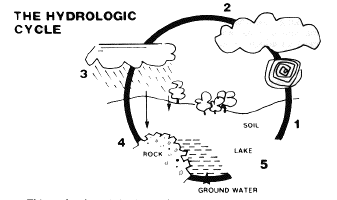

The story begins in the upper clouds where water exists as
almost weightless vapour particles. At this point it is similar
to distilled water pure H2O, free of impurities. Under certain
conditions, the particles combine and, when sufficiently large,
fall to earth as rain, snow, sleet or hail, or may appear as dew
or fog. As water in these varied forms sweeps the air, splashes
to the ground or seeps into the soil, it picks up mineral, gaseous
and bacterial impurities. Seventy percent of the water evaporates
into the atmosphere before seeping into the ground.
This cycle of precipitation and evaporation goes on endlessly.
Roughly three-fourths of all moisture soon returns skyward after
falling to earth. In fact, 70% of it may not even reach the ground
before evaporating. Of the water not quickly evaporated about
one-third becomes surface run-off, flowing into ponds, lakes and
rivers. The other two-thirds seeps into the soil to become part
of our groundwater supplies. Once underground, it may travel some
distance and for a period of many years before man pumps it to
the surface.
Regardless of whether water comes from a surface or underground
source, it has ample opportunity to pick up impurities before
reaching the taps in your home. Some of these impurities
tastes, odours, colour and turbidity are quickly noticed. But
even in water that is sparkling clear we cannot see such impurities.
We detect them only by their effects. Harmful bacteria, if untreated,
may lead to disease. Hardness minerals, if not removed, can produce
poor results. For example, clothes take on a dingy appearance,
when washed in hard water. Dishes and glassware often lose their
sparkle. And hair may become dull, unmanageable and lifeless from
the use of hard water with shampoos.
There is a common misconception that water as nature provides
it is best of all. Actually, most water for industrial, commercial
and household purposes is refined or treated. These improvements
on the raw product are necessary to make water safe to drink or
satisfactory to use.